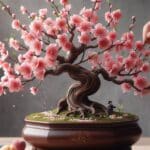Are you ready to bring a taste of the tropics into your home? If so, you may want to consider growing the Hawaiian umbrella bonsai.
This dwarf tree is native to the tropics (technically, to Australia and not Hawaii – but who’s keeping track?). It is common in parts of Southeast Asia as well.
Prized for its unique, radially-arranged leaves and its thin, delicate-looking trunk, this evergreen shrub is typically cultivated as a rock bonsai. It is prized for its unique aerial roots similar to those that you might find on a mangrove tree.
While you can grow a regular Hawaiian umbrella tree, Schefflera arboricola, as a bonsai, there is a dwarf form (dwarf schefflera bonsai) that works far better for this technique.
Interesting Facts about Hawaiian Umbrella Bonsai
| Height | 8-12” |
| Width | 8-12” |
| Sunlight | Dim lighting |
| Flowering Time Length | Does not flower |
| Lifespan | 100+ years |
| Scientific Name | Schefflera arboricola |
Growing Hawaiian Umbrella Bonsai from Seed or by Propagation
The Schefflera arboricola bonsai is a specimen that is best cultivated from seed. You can sow your seeds liberally in a mixture of loam, peat moss, and sand (or in specially formulated bonsai soil). Germinate the seeds at a temperature of around 68-86 degrees Fahrenheit after covering them with a thin layer of sand. The seeds should germinate quite rapidly.
How to Care for Schefflera Arboricola Bonsai
Sunlight
The Hawaiian umbrella tree, native to the tropics, is best kept indoors for most bonsai growers. You should keep it at temperatures of around 65 to 72 degrees Fahrenheit. It is okay if temperatures occasionally dip below this range, but you need to be careful about allowing it to get too cold – the tree will die at temperatures lower than 50 degrees.
It can sometimes be tricky caring for this tree species, since it requires ample ventilation but cannot be exposed to cold drafts. If you use a fan or open a window to provide some fresh air, just be sure that the air is warm enough.
Adequate lighting is also essential. Dwarf umbrella tree bonsai should be kept in relatively dim light, something that is uncommon among tropical plants. It can also tolerate low levels of humidity. Too much moisture or lighting can result in leaves that are small and underdeveloped.
Watering
Hawaiian umbrella trees prefer soil that remains moist and does not dry out. Water carefully in the winter, making sure the plant doesn’t dry out, especially if it is positioned near a heating source.
When you water, water thoroughly and deeply, making sure the water runs out of the drainage holes in the container to prevent the accumulation of salts from fertilizers. You can also use a humidity tray with stones to increase humidity while reducing the potential for root rot.
Fertilizing
Feed your bonsai plant once every four weeks with a bonsai fertilizer formulated to contain low amounts of nitrogen. Providing your plant with too much nitrogen will lead to too-large leaves at the expense of root and bark development.
Potting and Repotting
Hawaiian umbrella bonsai plants usually need to be repotted every two years, typically in the spring. Remove all large leaves when you do this and vigorously prune the roots to make sure the plant stays healthy.
Pruning Hawaiian Umbrella Bonsai
You can prune your Schefflera bonsai whenever the new shoots reach the desired length, based on the overall aesthetic you would like to achieve. You can remove the tips of these shoots and remove large leaves. Leaf stalks should fall off on their own.
Younger shoots can easily be wired, since they are more flexible, but you should exercise caution when you attempt to train older ones. They are likely to break.
Pests and Diseases
This indoor bonsai is unfortunately prone to several kinds of insects and diseases. Keep your tree healthy in order to prevent most issues and inspect it weekly so that you can stay on top of problems before they arise.
Make sure your tree drains adequately after each watering and remember that yellow leaves, sticky leaves, or those that are off-color generally indicate a problem with insects. Some of the most common include scale and spider mites, both of which can be treated with insecticides or in some cases, homemade solutions such as rubbing alcohol.
Where to Buy Hawaiian Umbrella Bonsai
You can purchase Hawaiian umbrella bonsai trees at most nurseries that specialize in tropical plants. However, it’s best to purchase a dwarf version of this tree, something that can often only be found at shops that specialize in bonsai plants.
FAQs
Do umbrella trees lose their leaves?
Yes, umbrella trees (Schefflera) can lose their leaves in response to stress, changes in environmental conditions, or improper care. Leaf drop may also occur naturally as older leaves age and are replaced by new growth.
How often do you water a Hawaiian umbrella plant?
Hawaiian umbrella plants (Schefflera arboricola) prefer evenly moist soil, but they are susceptible to root rot if overwatered. Water them thoroughly when the top inch of soil feels dry, typically every 1-2 weeks, and adjust watering frequency based on factors like temperature, humidity, and pot size.
Can umbrella plant be rooted in water?
Yes, umbrella plants can be rooted in water, although this method may take longer compared to rooting in soil. Select healthy stem cuttings with at least two leaf nodes, place them in a container of water, and change the water regularly to prevent stagnation and rot. Once roots develop, transplant the cuttings into well-draining soil to continue growth.
For more bonsai types you can grow, check our bonsai list.
*image by [email protected]/depositphotos







